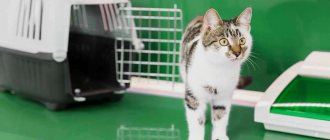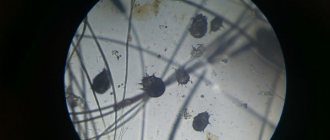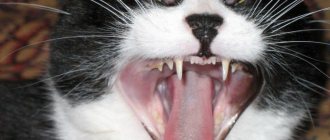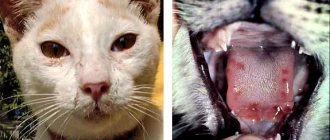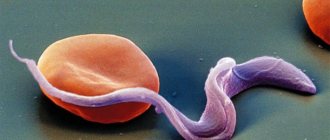Why do cats get urolithiasis?
Among the causes of urolithiasis (another name for urolithiasis) in cats are:
X-ray of kidneys in a cat suffering from urolithiasis
- errors in the diet (predominance of any substances in food);
- lack of water or its excessive saturation with salts;
- the presence of chronic diseases, foci of inflammation, metabolic disorders in the animal’s body;
- congenital or acquired anatomical features;
- hereditary factor.
Internal factors
In cats, 45% of uroliths consist entirely or partially of struvite (a salt of phosphorus and magnesium). Most stones form in sterile urine.
Endogenous causes of ICD:
- Infectious diseases. The formation of struvite uroliths (phosphates) is often associated with urinary tract infections caused by Stafhylococcus and Proteus bacteria. When pathogens enter the body, urease increases the concentration of ammonium in the urine, which leads to an increase in urine pH.
- Idiopathic hypercalcemia is an increased level of calcium in the blood. When plasma is filtered in the glomerular apparatus of the kidneys, calcium accumulates in the form of deposits.
- Obesity. With excess body weight, metabolic processes are disrupted, lipid processes in particular. Your furry friend develops the risk of developing other pathologies that impair diuresis.
- Violation of oxalic acid metabolism. The substance combines with calcium cations to form oxalates. With excessive acid excretion, the poorly soluble salt does not have time to be excreted and accumulates in the form of stones.
- Benign and malignant tumors.
- Developmental defects or acquired anatomical defects.
Be sure to read:
Instructions for use of Ipakitine for cats: composition, analogues, dosage
Pets with a genetic predisposition are at risk.
How does pathology manifest itself?
Finding out that a pet has urolithiasis at the beginning of its development will not work: he cannot complain of discomfort or problems with urination, so owners learn about the presence of a dangerous pathology when it has gone too far. You need to run to the clinic if the following symptoms of ICD appear:
Sign of urolithiasis based on the cat's posture
- the cat goes to the toilet not in its usual place, but anywhere;
- little urine is excreted; grains of sand and blood may be visible in it;
- the urge to urinate, on the contrary, becomes frequent;
- pain and irritation of the urinary tract by sand cause the cat to lick the urethra.
Gradually, the pet’s body temperature rises (up to 40˚C), he refuses food, and moves little. When urine cannot pass through the channels, the cat becomes very anxious, meows, and takes a characteristic pose to facilitate the outflow.
It is especially important to see a veterinarian in time if the cat is in critical condition, which is characterized by the following symptoms of urolithiasis:
- the stomach thickens, its volume becomes noticeably larger;
- since urine can no longer pass out, it stagnates in the bladder, causing severe tissue intoxication;
- the cat hardly moves;
- foamy saliva is released from the mouth;
- the animal’s temperature drops, the pet is trembling;
- vomiting is possible.
In the absence of timely assistance, the animal dies.
Important: intoxication occurs within a day after urination stops!
Is it possible to diagnose urolithiasis in a cat?
ICD in a cat can be diagnosed at the initial stages of the disease if examinations are carried out regularly. Methods such as:
- urine tests (general and microscopic polarized);
- X-ray;
- Ultrasound of the abdominal organs.
During the diagnosis, the veterinarian will definitely ask the owner about the conditions under which the cat is kept, its physical characteristics, previous diseases and other nuances. It is important to tell when you noticed the first signs of the disease, how often they appear, and so on.
Treatment of urolithiasis in cats
When visiting a veterinarian with an attack of urolithiasis in cats, treatment of the disease must begin with restoring the patency of the urinary tract. A catheter is used to remove urinary stones or clear out accumulated sand. All manipulations are performed under general anesthesia. After the formations are removed, the lumen of the urethra is thoroughly washed with an antiseptic solution.
In difficult situations, doctors must first create an artificial excretory duct - this intervention is called urethrostomy. However, for very large deposits that greatly exceed the diameter of the urethra, abdominal surgery is performed, directly removing the stones.
Further treatment is aimed at normalizing the acid-base balance in the pet’s body and cleansing it of toxic products. At the same time, the inflammatory process is eliminated by prescribing antibiotics and anti-inflammatory drugs. The total duration of therapy can be 14 days or more, depending on the complexity of the intervention, the condition of the animal and other circumstances.
Features of drug therapy
For the treatment of urolithiasis, a mustachioed patient may be prescribed different groups of medications:
- painkillers (often Papaverine, Analgin);
- antibiotics (for example, Ceparin);
- medications that eliminate the inflammatory process (Palin, Furagin and others);
- antispasmodic drugs (Baralgin).
If necessary, maintenance therapy is indicated. These may be: vitamin complexes, drugs aimed at normalizing heart function, drugs to restore the digestive tract. All medications are prescribed only by a veterinarian in accordance with the age and gender of the cat.
What to do after treatment
Regardless of the complexity of the treatment (even if a cat’s urolithiasis was detected at an early stage), the pet’s future life should take place under constant preventive measures. The owner will be required to regularly examine the pet: submit urine for analysis and do ultrasound diagnostics of the urinary system.
In addition, the cat should be immediately switched to an appropriate diet that excludes components that provoke the development of the disease. If necessary, your mustachioed friend will need to be periodically given antibiotics and/or diuretics.
Questions for a veterinarian therapist
In such an acute condition, the animal usually dies within 4 days.
Drug therapy is aimed at getting rid of the very cause of the disease and is a long and painstaking process. The very first aid is to install a catheter in the urethra in order to establish normal urination. If for some reason manipulation through the penis is not possible, catheterization is performed surgically, removing the tube directly through the abdominal cavity, while simultaneously clearing the bladder of stones and sand.
It is used when there is a small amount of sand or stones, and there is no danger of blockage of the urinary duct.
Antibiotics are required, usually amoxicillin and nitroxoline (a special drug to suppress urological infections). To relieve pain and spasms, use baralgin, no-shpu, papaverine.
Indicated for blockage of the ducts with a stone, the shape of the stone with sharp edges, large size and the presence of a bacterial infection and urine intoxication.
To do this, the stones are removed surgically by washing the bladder with Metragil solution.
After surgery, antibiotic therapy, painkillers and antispasmodics are also used.
For general strengthening, it is recommended to prescribe phyto-medicines – Phytolysin and Phytoelita.
What to feed a cat with urolithiasis
Only with proper nutrition can a cat diagnosed with ICD live painlessly for several more years. Since some pets prefer exclusively dry food, while others prefer homemade food, approaches to diet will vary.
Dry food for a cat with ICD: which one to choose
Most dry food is completely unsuitable for feeding a cat with urolithiasis - they contain too many mineral salts. But there are also special mixtures that can be selected depending on the type of urinary stones, for example:
- Oxalates – Royal Cannine Urinary S/O LP34, Hill's PD Feline K/D;
- Struvite – Purina Pro Plan Veterinary Diets UR, Hill's Prescription Diet C/D.
You only need to buy food that belongs to the premium and super-premium class.
How to feed your cat homemade food
Home feeding of a cat with urolithiasis also depends on the type of stones. Since the high acidity of urine is caused by calcium, you need to limit your pet to eggs and milk (and their derivatives). Vegetables rich in this element should also be excluded from the cat's diet. In addition, with oxalates, it is extremely undesirable to give your pet offal, since they contain a large amount of oxalic acid.
Monotony in food should be avoided. The cat's menu should be based on meat dishes, while adding industrial food of any kind to the food is prohibited.
It is important to provide the animal with free access to water. Since cats drink little, you need to try to teach your pet to regularly visit the watering hole. The water bowl should not be located next to the food bowl so that the cat does not turn his attention to the food.
Nutrition: enemy and ally
Malnutrition in cats is one of the provoking factors for the development of urolithiasis. Therefore, when choosing food, you need to consider the following nuances:
- A number of feeds contain excess amounts of phosphorus, magnesium, and calcium. These elements contribute to the formation of crystals in urine.
- The food has a significant effect on the acidity of urine (pH). The cat’s body is “tuned” to digest animal food, which makes the urine slightly acidic, and therefore prevents the formation of stones. In such an environment, crystals dissolve. If the diet is dominated by products of plant origin, which is often found in cheap brands, the pH of the urine shifts towards slightly alkaline. And this contributes to the formation of struvite - one of the most common types of stones.
The likelihood of developing the disease increases if the cat drinks little. In this case, the urine becomes too concentrated and stones form faster.
Important facts about urolithiasis in cats
There are several important facts about ICD in cats that every owner should know.
- Cats living in hot environmental conditions are at risk, as elevated temperatures cause urine to thicken and increase its concentration.
- It has been noted that most often urolithiasis develops in animals aged 2-6 years.
- Obese cats who are overweight are also more likely to develop urolithiasis than thin or normal weight cats.
- A predisposition to the deposition of stones in the urinary system is observed in cats of long-haired breeds.
- Due to the narrow urethra, the disease affects cats more often than cats.
- The disease is more often noted in cats after castration, as well as in cats whose estrus is “in vain.”
- Experts have noticed that in cats suffering from urolithiasis, relapses are observed more often in the autumn (especially at the beginning) and from the 1st to 4th months of the year.
- The formation of struvite is more often observed in animals under 6 years of age. At the same time, the formation of oxalate stones is more typical for cats older than 6-7 years.
Urolithiasis in neutered cats: true or false
The development of urolithiasis in castrated cats is confirmed by statistical data. However, there is no scientific confirmation of the direct effect of castration on the formation of stones. It turns out that both facts contradict each other. In fact, castration has an indirect effect and leads to ICD indirectly.
A castrated animal experiences a sharp hormonal imbalance. Changes in the activity of the endocrine glands contribute to the appearance of slowness, some passivity in cats (although a young pet can be very active), and calmness in behavior. As a cat ages, it moves more slowly, reacts less to stimuli, including those of the opposite sex, and eats more. All together causes excess weight, sometimes obesity.
It is known that most animals that are overweight sooner or later develop urolithiasis. Moreover, the slow metabolism of castrates causes rare emptying of the bladder, which leads to congestion. And if the operation was performed too early, then the urinary canal remains underdeveloped and narrow, which also provokes the formation of stones. We can conclude that castrated cats are indeed at risk.
Surgery to remove stones from a cat's kidneys
- Before the operation, the animal should not be fed for about a day, as there is a risk that the cat may inhale the vomit and choke on it while under anesthesia.
- After surgery (if there are no contraindications), it is necessary to ensure that the animal receives a sufficient amount of fluid.
- You should also find out what medications will be used during medical procedures and whether your cat is allergic to them. If yes, ask your veterinarian what to do in this case.
Your cat will also need post-operative care to ensure she is comfortable. Listen carefully to your veterinarian's recommendations. Your cat may need additional treatment and visits to the veterinarian. A veterinarian can analyze stones removed from a cat's kidneys in a laboratory to determine their exact mineral composition and prescribe the correct treatment to prevent the cat from developing kidney stones in the future.
Cats need surgery in the following cases:
- Stones in the kidneys or bladder are very large and cannot pass on their own.
- Calcium oxalates are found in the body. Since they do not dissolve, they will have to be removed surgically.
- The urinary ducts are blocked.
There are two types of stone removal operations:
- Urethrotomy. A small hole is made in the urinary duct through which the stones are removed. Until the cat's health improves, the hole is not allowed to close.
- Cystotomy. This operation is used only in the most severe cases, when there is little chance of cure. The essence of it is that the cat’s bladder is opened and stones are taken out. Such complex intervention is undertaken only when the stones are very large and cannot be removed in any other way.
How to prevent urolithiasis in cats
Prevention of urolithiasis in cats is as follows:
- monitor the diversity of your pet’s diet, and if the need arises, purchase specialized food;
- avoid the development of obesity by controlling the caloric content of food (for this you can contact a specialist);
- encourage regular water consumption by ensuring its availability and freshness;
- keep the animal active, preventing laziness from developing;
- do an ultrasound every six months, especially if there is a predisposition to urolithiasis;
- regularly submit your cat’s urine to the clinic to test for salts;
- undergo a full course of treatment if sand or stones are detected.
Such simple measures will ensure the health of your mustachioed pet for many years. If the cat has already been treated for urolithiasis, then they will help avoid relapse, because it is impossible to completely get rid of this pathology.
Prevention
To prevent the occurrence of pathology, it is necessary to exclude the causes of its occurrence:
- Normal food.
- Give the animal plenty of quality water to drink.
- If you are not breeding, neuter your cat in a timely manner (optimally between seven months and one year of age).
- Do not overfeed your pet and provide him with enough space and opportunities for active movement (slides, toys, and also play with him yourself).
- Vaccinate your pet promptly to prevent infectious diseases.

